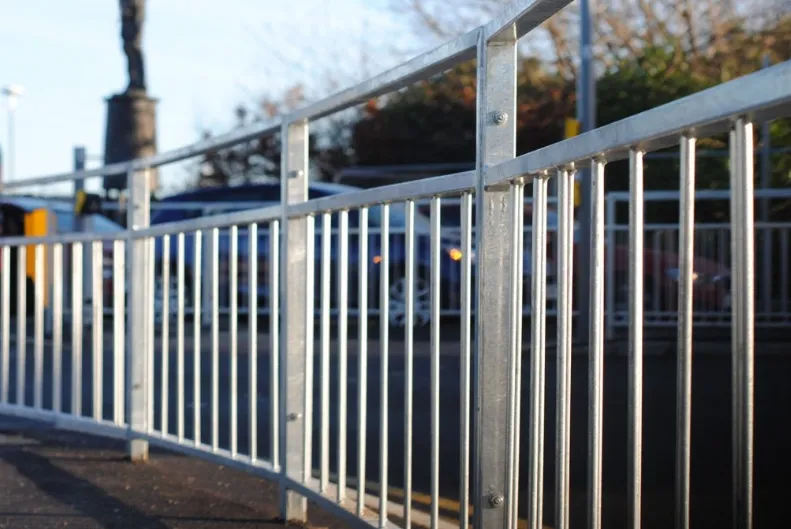The Role of Pedestrian Guardrails in Construction Zone Safety

In bustling urban areas and along highways, construction zones are a common sight. These areas pose numerous hazards to both workers and pedestrians, making safety measures paramount. Among these measures, pedestrian guardrails play a crucial role in safeguarding individuals navigating through or near construction sites. This article delves into the significance of pedestrian guardrails in construction zone safety, exploring their design, placement, and impact.
Contents
Understanding the Purpose
Pedestrian guardrails serve as protective barriers, delineating safe pathways for pedestrians amidst construction activities. Their primary purpose is to prevent accidental falls into excavations, trenches, or other hazardous areas within construction sites. By providing a physical barrier, these guardrails reduce the risk of injuries and fatalities, thereby enhancing overall safety.
Design Considerations
Effective pedestrian guardrails are designed with several key considerations in mind. Firstly, they must be sturdy and durable enough to withstand potential impacts. Materials such as steel, aluminum, or reinforced plastic are commonly used for their strength and longevity. Additionally, guardrails should be sufficiently tall to deter unauthorized access while still allowing visibility of the construction area to pedestrians.
Moreover, the design should ensure ease of installation and relocation as construction progresses. Modular guardrail systems, for instance, offer flexibility and adaptability to varying site conditions. This allows for quick adjustments to accommodate changing safety requirements throughout the construction process.
Placement and Installation
Strategic placement of pedestrian guardrails is essential for effective safety management within construction zones. Guardrails should enclose hazardous areas such as open excavations, machinery, or elevated platforms. Additionally, they should be positioned along pedestrian pathways to guide foot traffic away from potential dangers.
Proper installation is critical to ensure the stability and integrity of guardrail systems. Guardrails must be securely anchored to the ground or other structural elements using appropriate fastening methods. Regular inspections during installation help identify any defects or weaknesses that may compromise their effectiveness.
Compliance with Regulations
Construction projects must adhere to regulatory standards governing pedestrian safety, including requirements for guardrail installation. Regulations such as those set forth by OSHA (Occupational Safety and Health Administration) in the United States outline specific guidelines for guardrail design, height, and strength to ensure adequate protection for workers and pedestrians.
Furthermore, compliance with local building codes and ordinances is paramount to avoid penalties and legal liabilities. Construction companies and contractors are responsible for familiarizing themselves with relevant regulations and implementing appropriate safety measures accordingly.
Impact on Safety
The presence of pedestrian guardrails significantly reduces the risk of accidents and injuries within construction zones. By creating a physical barrier between pedestrians and potential hazards, guardrails minimize the likelihood of falls, collisions, or other mishaps. This not only protects the well-being of workers and passersby but also mitigates the financial and reputational costs associated with accidents on construction sites.
Moreover, the visible presence of guardrails serves as a visual cue to pedestrians, signaling the need for caution and awareness of the surrounding environment. This proactive approach to safety helps foster a culture of risk awareness and compliance among workers and visitors alike.
Why Pedestrian Guardrails?
Pedestrian guardrails serve several critical purposes in various settings, including urban areas, highways, and construction zones. Here are some reasons why pedestrian guardrails are essential:
Safety: The primary purpose of pedestrian guardrails is to enhance safety for pedestrians. By providing a physical barrier between pedestrians and potential hazards such as traffic, steep drops, or construction activities, guardrails help prevent accidents, falls, and collisions.
Risk Mitigation: Pedestrian guardrails mitigate the risk of accidents and injuries by guiding pedestrians away from dangerous areas. Whether it’s a busy roadway, a construction site, or a steep embankment, guardrails create a clear boundary that prevents unintended access to hazardous zones.
Compliance: Many jurisdictions have regulations and standards in place that mandate the use of pedestrian guardrails in specific locations, such as bridges, highways, and construction sites. Compliance with these regulations is essential for ensuring the safety of pedestrians and avoiding legal liabilities.
Accessibility: Pedestrian guardrails improve accessibility by providing designated pathways for pedestrians, particularly in areas with heavy foot traffic or limited space. They help organize pedestrian flow and prevent congestion, making it easier for people to navigate urban environments safely.
Visual Cue: The presence of pedestrian guardrails serves as a visual cue to pedestrians, alerting them to potential hazards and signaling the need for caution. This visual reminder encourages pedestrians to stay within designated pathways and remain vigilant of their surroundings.
Aesthetic Enhancement: In addition to their functional role, pedestrian guardrails can also contribute to the aesthetic appeal of public spaces. Thoughtfully designed guardrails can complement the architectural style of their surroundings and enhance the overall visual aesthetics of urban areas.
Flexibility: Modern pedestrian guardrail systems offer flexibility in design and installation, allowing for customization to suit specific site requirements. Modular guardrail systems, for example, can be easily adjusted and reconfigured to accommodate changes in terrain or construction layouts.
Public Confidence: The presence of well-maintained pedestrian guardrails instills confidence in the public regarding the safety of pedestrian infrastructure. Knowing that appropriate measures are in place to protect pedestrians from harm can improve trust in urban planning and development initiatives.
Overall, pedestrian guardrails play a crucial role in promoting pedestrian safety, managing risk, and enhancing the functionality and aesthetics of public spaces. Their importance cannot be overstated in creating safe and accessible environments for pedestrians to navigate and enjoy.
Conclusion
In conclusion, pedestrian guardrails play a vital role in ensuring safety within construction zones. Through their robust design, strategic placement, and compliance with regulations, these barriers effectively mitigate risks associated with construction activities. By prioritizing pedestrian safety, construction companies demonstrate their commitment to protecting lives and promoting a culture of safety in the built environment.



